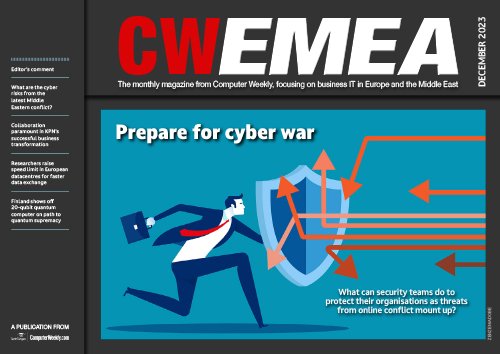Recent Blog Posts

When IT Meets Politics
Warlords v Merchants: who really controls ID and Information Policy
Winsafe Ltd 19 Dec 2025Sooner or later we will have to interface with the global market leaders, including for ID systems and the UK will be a more prosperous and secure place to live, work and do business if we do so ...

When IT Meets Politics
The politics of cyber security and identity: Warlords versus Merchants (first published 2011)
Winsafe Ltd 19 Dec 2025The current hype in support of additional US and UK government spend on cybersecurity has prompted me to return to my "Warlords versus Merchants" theme. It is not that I do not believe that ...

Software application development, architectural planning procedures and deployment-time analysis (as well as post-deployment live production analytics) all need observability and insight. In short, ...

Companies, both small and large, are starting to adopt AI videos not only for ads, but for marketing content, comms and education. As production costs drop thanks to AI, it becomes much easier for ...

CW Developer Network
Stack Overflow: The invisible platform engineer: why developers still need human interaction
18 Dec 2025This is a guest post for the Computer Weekly Developer Network written by Peter O'Connor, Senior Director, Engineering, Stack Overflow. Stack Overflow is known for its developer question and answer ...

Agents have gone to work. Software application development in the artificial intelligence space has delivered a new cohort of digital workers for in the form of agentic AI services, which now ...

CW Developer Network
Zoho Creator - How AI-powered low-code platforms streamline developer self-service
16 Dec 2025This is a guest post for the Computer Weekly Developer Network written by Bharath Kumar B, head of customer experience and success at Zoho Creator. Zoho Creator is known as a cloud-based low-code ...

Zen and the Art of Motorcycle Maintenance was Robert Pirsig’s seminal book that looked into the values of life. By uncommon coincidence, perhaps, AI-first software code orchestration layer company ...

Open Source Insider
Self-service tools - Percona: Making compliance & data management self-service
16 Dec 2025This is a guest post written by Briana Swifft, director of solutions marketing at Percona. Swift writes in full as follows… Developers build software to meet specific needs or goals, often by ...

Nutanix continues to expand its multi-cloud strategy, platform and tools with a diversity of interests and capabilities. The organisation’s latest moves see it detail a new enterprise ...

Artificial intelligence has already learned to read, write and reason. In 2026, it’s learning to look, listen and respond in real time. The next frontier for human–computer interaction is visual. ...

CW Developer Network
Refactoring the C-Suite: Why leadership needs a ‘full stack’ architecture rewrite
12 Dec 2025This is a guest post for the Computer Weekly Developer Network written by Lee Whitmore, author, podcast host and leadership coach. With a thorough understanding of software application development ...

AI-driven DevSecOps company Sonatype has come forward with Sonatype Guide. This is a developer tool designed to make AI-assisted software development faster and safer. With some many AI coding ...

HPE starts its press statements with a quote, straight up, no preamble. Recent work emanating from the company sees Fidelma Russo, executive vice president of hybrid cloud and CTO at HPE remind us ...

Cliff Saran's Enterprise blog
2025: The year we rode the enterprise AI wave
Managing Editor 11 Dec 2025With the start of the Christmas festivities and the year coming to a close, the team at Computer Weekly has been looking back on what the last 12 months has meant for corporate IT. What is ...

Enterprise software application development is continually charged with the need to simplify, coalesce and automate core functions into what vendors often call a unified platform, a single pane of ...

Every year, Computer Weekly compiles a list of excellent women in the technology industry with a focus on a particular trait: “influential”. But what does influence actually mean? When the judges ...

AI is here, but is it? Through the rise and development of predictive, generative and agentic AI services, we have heard so many vendors (and indeed AI advocates and evangelists) tell us about the ...

CW Developer Network
Ataccama Snowflake partnership aims to solidify data trust leadership
10 Dec 2025Agentic data trust company Ataccama has announced a key development (actually a strategic investment) with Snowflake Ventures. Snowflake Ventures is the corporate venture capital (CVC) arm of ...

CW Developer Network
LangGrant LEDGE: LLM enterprise database (orchestration) governance engine
09 Dec 2025Database modernisation and synthetic data company LangGrant has launched LEDGE MCP server. This technology enables LLMs to reason across multiple databases at scale, execute multi-step analytics ...

CW Developer Network
SmartBear: Context is the new code: why self-service QA will deliver AI’s promised productivity
09 Dec 2025This is a guest post to follow up the recent Computer Weekly Developer Network series on self-service computing written by Scott Kingsley, VP of engineering, SmartBear. SmartBear is known for its ...

Many of our core enterprise computing infrastructure core contrasts are changing. Where we were concerned with CPU ‘clock speed’ and the relative performance of any given member of the Intel ...

AWS used its re: Invent conference to announce Kiro, an AI IDE that helps software engineers move from concept to production through a simplified developer experience for working with AI agents. ...

AWS used its re: Invent 2025 conference to detail its work focused on simplifying model customisation to help developers build faster, more efficient AI agents. The company says that, now, Amazon ...

Cliff Saran's Enterprise blog
Don’t be a Scrooge when it comes to AI’s role in enterprise software
Managing Editor 04 Dec 2025Let’s assume that artificial intelligence (AI) delivers everything that is being promised. How will it alter the world of corporate IT, IT service providers and the deployment of commercial ...

CW Developer Network
AWS data & analytics VP: Charting new oceans, the evolution of data lakes
03 Dec 2025Data lakes represent an ocean of information resources… and much like our blue planet’s waters, many of the depths remain uncharted and occasionally mysterious. Our notion of data lakes has ...

CW Developer Network
Amazon Bedrock AgentCore tools-up for agentic AI software development
03 Dec 2025AWS used its re: Invent 2025 conference to announce new developments in Amazon Bedrock AgentCore, its platform for building and deploying agents. In a world where we all want to know where AI ...

Computer Weekly Editors Blog
Digital ID providers are placated (again) as anticipation builds towards government consultation
Editor in chief 03 Dec 2025Yesterday (2 December 2025) was the second time this year that a confused and – in some quarters – angry digital identity sector was given the opportunity to sit down with the government and ask: ...

Developers, developers, developers… right? Wrong, it’s now developers, developers, agentic service constructs designed to provide autonomous app design, code reviews and penetration testing that ...

CW Developer Network
AWS recalibrates data economics further with S3 Vectors, batch & Intelligent-Tiering
02 Dec 2025AI needs data, AI needs inter (and intra) data repository contextual linking and AI needs all of that with a whole menu of search types spanning contextual search, semantic search, SQL search and ...

Because vector workloads aren’t one-size-fits, many applications, such as RAG systems, agents, prototypes and scheduled jobs, have “bursty workloads” meaning that they maintain low, steady traffic ...

CW Developer Network
Adaptavist: Why culture is king for successful self-service developer tools
30 Nov 2025This is a guest post for the Computer Weekly Developer Network written by Matt Saunders, VP DevOps, Adaptavist. It's becoming more widely accepted that any organisation with a large number of ...

CW Developer Network
Digitate on AI Workflows: The next frontier in enterprise automation
28 Nov 2025How intelligent orchestration platforms are reshaping enterprise operations - and redefining the employee experience. Author: Efrain Ruh, regional CTO, Digitate... Workflow platforms have long ...

CW Developer Network
Self-service tools - Sonatype: The unseen risks lurking inside the platform
28 Nov 2025Mitun Zavery, regional vice president at Sonatype says that there are "unseen risks" lurking inside self-service developer platforms. Zavery suggests that self-service platforms are now standard ...

Data Matters
Giving ourselves the chance to lead the AI race, and stay ethical too
Enterprise Applications Editor 26 Nov 2025This is a guest blog post by Denas Grybauskas, Chief Governance and Strategy Officer at Oxylabs. Within the UK and Europe more broadly, many companies developing AI are having to balance an ...

Cliff Saran's Enterprise blog
Revolution in pet care shows tech innovation has no limits
Managing Editor 26 Nov 2025We are a nation of dog and cat lovers. A study from PDSA, the vet charity for pets in need, has estimated that there are 11.1 million dogs in the UK and 10.5 million cats. In November 2024, ...

CW Developer Network
Self-service tools - Snyk: The unbearable weight of full-stack ownership
22 Nov 2025This is a guest post for the Computer Weekly Developer Network, written by Randall Degges, head of developer relations & community, Snyk. Degges writes in full as follows... Let’s be honest: ...

NTT, Inc. used its recent NTT R&D Forum in Tokyo to detail a new AI technology called the Large Action Model (LAM). What is a LAM? The is an AI model that predicts customers' intent based on ...

Cliff Saran's Enterprise blog
Digital service uptime must be top of the boardroom agenda
Managing Editor 21 Nov 2025The tech sector often speaks about IT as a fourth utility alongside gas, electricity and water. But these are highly regulated industries. Some tech firms that provide systems to customers in ...

Spookily-named AI-native data loss prevention platform company Nightfall has now detailed the shape of its new ‘AI File Classifier Detectors’, a software service deisgned to use large language ...

As the march (let’s not say race) towards building, implementing and interconnecting intelligence functions into enterprise software stacks deepens, the palpable (but largely friendly) division ...

CW Developer Network
Self-service tools - PagerDuty: The shift from ‘we deploy’ to ‘you deploy, we observe'
18 Nov 2025This is a guest post for the Computer Weekly Developer Network written by Mandi Walls, DevOps advocate at PagerDuty. Walls, in her inimitable style, writes in full as follows… Organisations are ...

NTT and OptQC aim to build a 1-million qubit quantum computer built on light-based photonics principles (rather than electricity) to enhance the reliability, scalability and practicality of the ...

NTT Inc. CEO Akira Shimada kicked off the NTT R&D Forum 2025 conference this year, with the event itself billed as a “Quantum Leap Into The Future”, this gathering was designed to clarify and ...

Data Matters
Supply chains are the overlooked risk in industrial cybersecurity
Enterprise Applications Editor 17 Nov 2025This is a guest blogpost by Magpie Graham, technical director of threat intelligence, Dragos. The resilience of the UK’s critical infrastructure increasingly depends on trust. Or rather, how far ...

CW Developer Network
IFS industrialises humanoid robotics with 1X, partners with Siemens
17 Nov 2025IFS has detailed a new partnership with 1X Technologies (1X), to jointly industrialize humanoid robotics for asset-intensive industries. The collaboration will combine 1X’s humanoid robots with ...

The Ataccama Data Trust Summit continued into its second day with an examination of how data trust is delivered through the company’s platform and toolset - readers can catch up on day 1 here, ...

KubeCon + CloudNativeCon North America was busy. Although some have said not ‘quite’ as busy as expected (it was -3 centigrade and there was a US government shutdown impacting travel, plus there’s ...

There are technology press events aplenty. But aside from the standard fodder of the press conference, the technology symposium, the C-suite exec Zoom-style update call (possibly with earnings ...

CW Developer Network
IFS validates applied Industrial AI platform with real-world impact showcase
13 Nov 2025AI is everywhere, clearly. It’s not too far of a stretch to say that we have AI, AI everywhere, but not a drop to drink i.e. so many projects fail (95% according to MIT research), or lay ...



